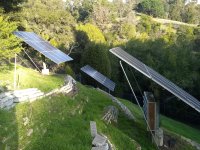Williy
Elite Member
- Joined
- Apr 26, 2020
- Messages
- 3,627
- Location
- Texas
- Tractor
- Yanmar YT 235C Yannar YRC 60 rotary cutter, Yanmar RT72 rotary tiller B75 Backhoe & bucket & thumb, LS land grader
I find the same thing here with gas powered vehicles. Speed limit
in town is 40 and you usually get some slow poke joker will be doing
20 to 25 in the other lane and when they see you coming jump in front
of you trying to slow you down. This only happens when I have the car I purchased chains for my old 1973 3/4 ton Dodge 975x16.5 won't fit my tractor but can add some chain to; make them work. Our VW bug I had chains for it and when you get them on snug you have a T handled wrench and in the middle of the chains a metal disk insert T handle and chains are snug never come loose.
willy
in town is 40 and you usually get some slow poke joker will be doing
20 to 25 in the other lane and when they see you coming jump in front
of you trying to slow you down. This only happens when I have the car I purchased chains for my old 1973 3/4 ton Dodge 975x16.5 won't fit my tractor but can add some chain to; make them work. Our VW bug I had chains for it and when you get them on snug you have a T handled wrench and in the middle of the chains a metal disk insert T handle and chains are snug never come loose.
willy

